Picking out the right bathroom vanity can really change the vibe of your space. It’s not just about function—it’s about style, too. A thoughtfully designed vanity becomes the main feature in your bathroom, giving you the storage and utility you need for daily life. The best bathroom vanities manage to balance form and function, blending practical solutions with a design that fits your bathroom’s personality.
Remember to repin your favorite images!
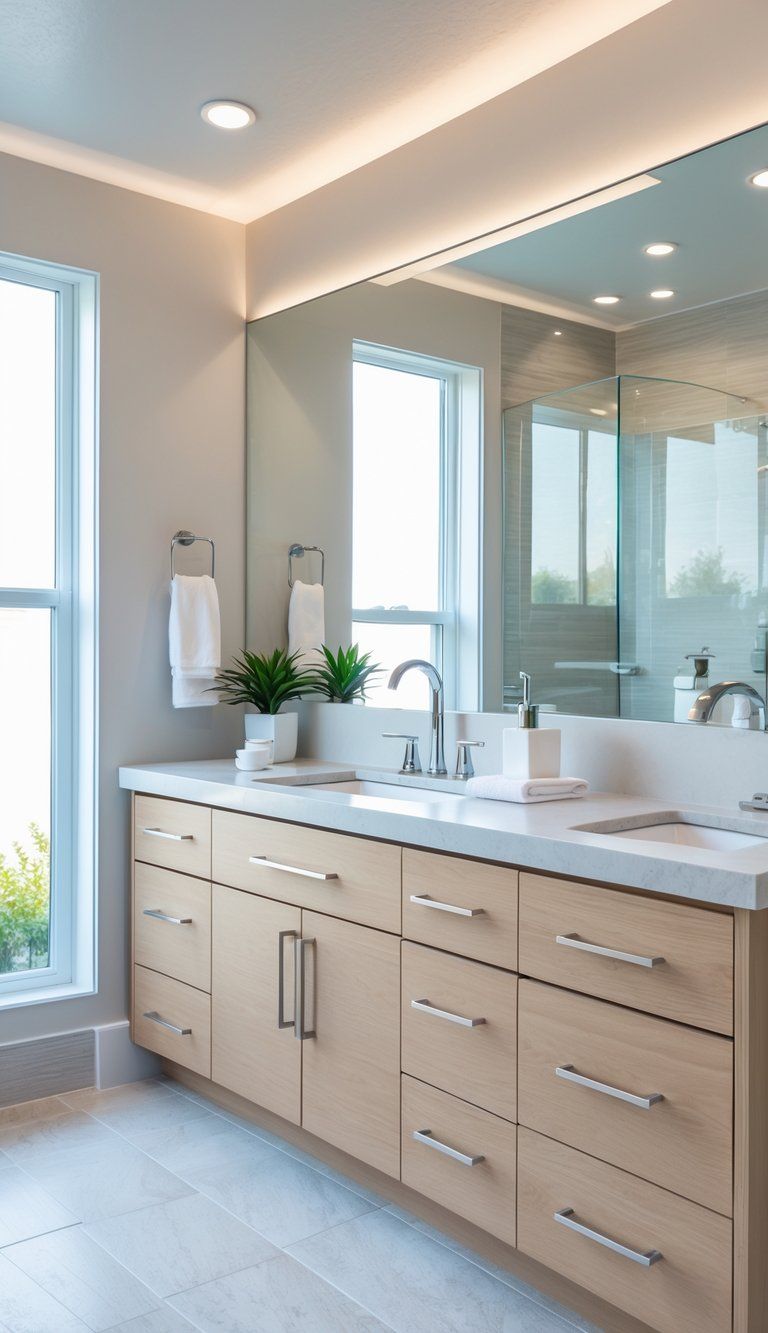
Bathroom vanities come in all kinds of styles, so you can find something that fits your needs. Maybe you want a floating design to open up the floor, or you’re drawn to vintage-inspired pieces for a little character.
If you love modern minimalism or prefer something more classic, there’s definitely a vanity out there that’ll add charm to your bathroom and help you stay organized.
When you pick between single or double vanities, built-in cabinets, or freestanding units, you shape both the look and the function of your bathroom. The right vanity gives you a spot for your sink and sets the mood for the whole room.
Even small details, like a reeded front or a bold mirror, can turn a basic vanity into a highlight that makes your routine feel a bit more special.
Core Elements of Bathroom Vanity Styles
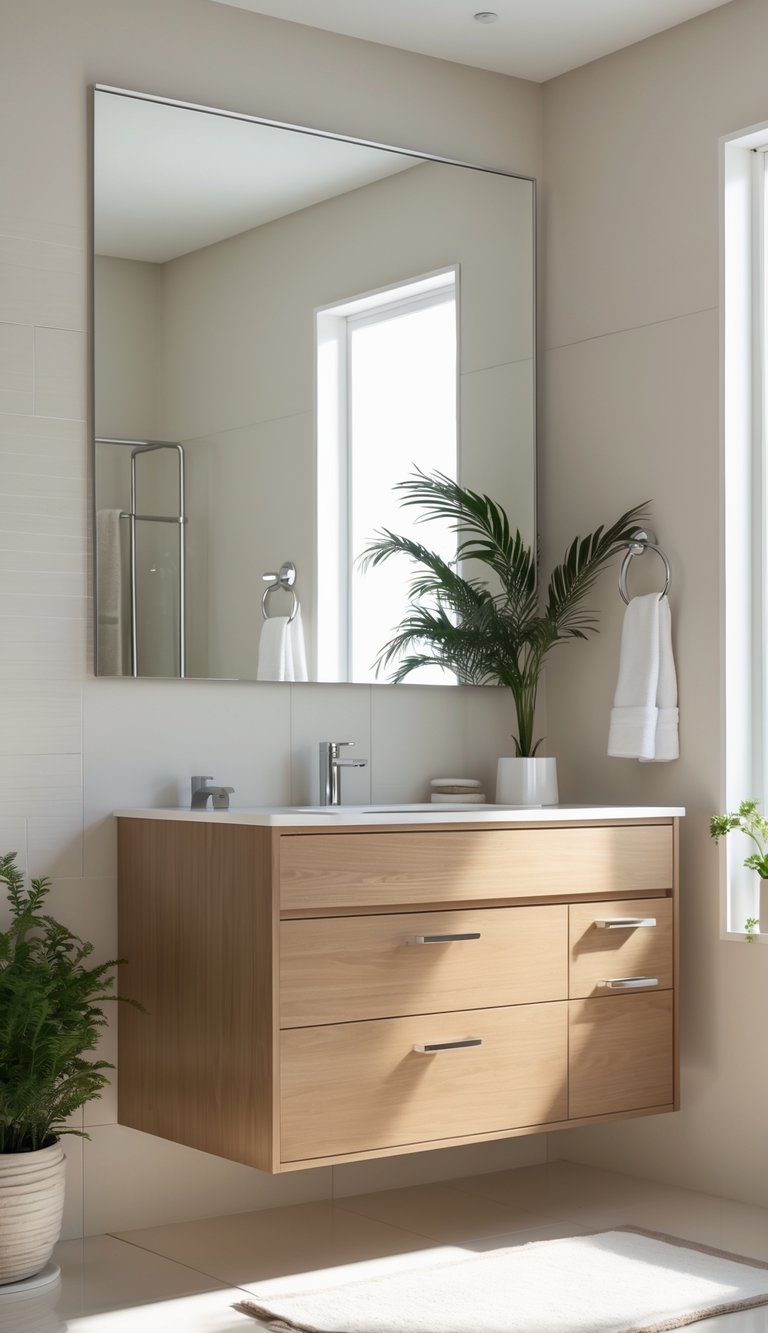
A good bathroom vanity should look great and work well. It’s both a design statement and a functional workspace.
If you understand the main components of different vanity styles, you’ll have a much easier time picking one that actually fits your day-to-day needs.
Balancing Form and Function
The best vanities don’t just look good—they work for your life. Before you settle on a style, think about how you’ll actually use the space.
A family bathroom usually needs more counter area than a guest bath. Height matters for comfort, too. Most vanities stand at 32 inches, but comfort height (36 inches) can help your back.
Materials make a big difference in both looks and durability. Solid wood feels timeless, but it needs a bit of upkeep if your bathroom gets steamy. Quartz countertops are great for resisting water and don’t ask for much maintenance.
If your bathroom is small, wall-mounted vanities open things up and make cleaning easier. Freestanding vanities work best in bigger rooms and can become a real focal point.
Integrating Ample Storage
Smart storage turns a plain vanity into an organizing powerhouse. Drawers usually keep things more accessible than cabinets, so you don’t lose stuff in the back.
Try out these storage ideas:
- Drawer dividers: Separate small things so they don’t get lost
- Pull-out shelves: Reach items in deep cabinets without digging
- Medicine cabinets: Use wall space for extra storage
- Open shelving: Show off a few nice things while keeping essentials close
Custom inserts for hair tools, makeup, and toiletries can really help maximize your space. If you add vertical storage next to the vanity, you get more room without crowding the counter.
For shared bathrooms, dual-sink vanities give everyone their own spot. These usually start at 60 inches wide and include separate storage for each person.
Influence on Overall Bathroom Design
Your vanity sets the style tone for the whole bathroom. Modern vanities lean into clean lines and simple hardware, often mixing in glass or metal for a fresh look.
Traditional styles show off details like fancy woodwork and classic hardware. Transitional vanities mix both worlds, so they work in a lot of homes.
The finish you choose can totally change the mood. Dark finishes feel dramatic and cozy, while lighter colors make the room seem bigger and brighter.
Handles and knobs—whether they’re sleek or ornate—give your vanity real personality. Swapping out hardware is a small change that can make a big difference.
Custom lighting above or around the vanity doesn’t just help with grooming—it brings out the style and makes the space feel inviting.
Modern Bathroom Vanity Styles
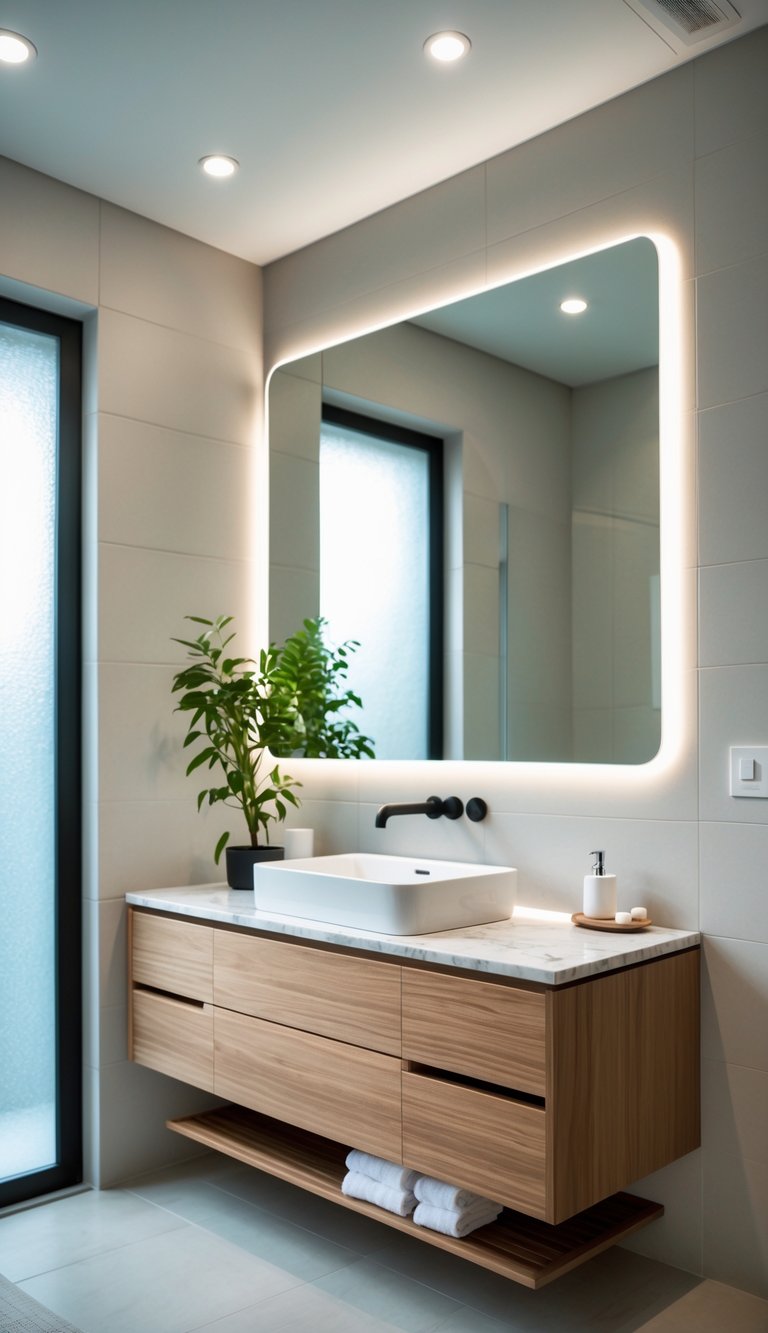
Modern vanities blend sharp design with features that make life easier. You’ll notice clean lines, smart storage, and a look that grabs attention without being fussy.
Minimalist Vanities With Clean Lines
Minimalist vanities keep things simple but still make a statement. Flat panel doors, hidden hardware, and straight edges give them that crisp, uncluttered vibe.
People love materials like matte finishes, glossy lacquer, or natural wood with just a hint of grain. For a little edge, black frames with natural wood pull off that industrial-chic look.
Storage stays practical but subtle. Push-to-open drawers and cabinets skip the handles, so the whole thing looks seamless.
Neutral colors—white, black, gray, and wood tones—dominate. They create a backdrop that won’t feel dated any time soon.
Floating and Wall-Mounted Designs
Floating vanities attach straight to the wall, making the floor look more open. They’re a lifesaver in small bathrooms where you want things to feel less cramped.
The space underneath makes cleaning a breeze and helps the room feel bigger. Some folks even add lighting under the vanity for a cool, modern touch.
Popular features include:
- LED lighting built into mirrors
- Wall-mounted faucets to save counter space
- Hidden plumbing for a cleaner look
- Streamlined storage drawers
These vanities usually sit 30-36 inches from the floor, but you can tweak the height to fit whoever uses the bathroom most. That flexibility is pretty handy.
Double Sink and Trough Basin Vanities
Double sink vanities give two people their own space while keeping everything looking tidy. Modern versions use a symmetrical layout with storage in the middle.
Trough basins offer a sleek twist with one long sink that two people can use at the same time. It’s a smart pick if you care more about counter space than separate sinks.
Mixing materials adds interest—think concrete counters on wood cabinets or marble tops on matte black bases. These combos keep things textured but still clean.
You’ll usually find a mix of drawers and cabinets for storage. Drawers work for small stuff, cabinets for bigger bottles or cleaning gear. Some vanities include open shelves for a bit of display or easy access to daily items.
Transitional and Classic Vanity Styles
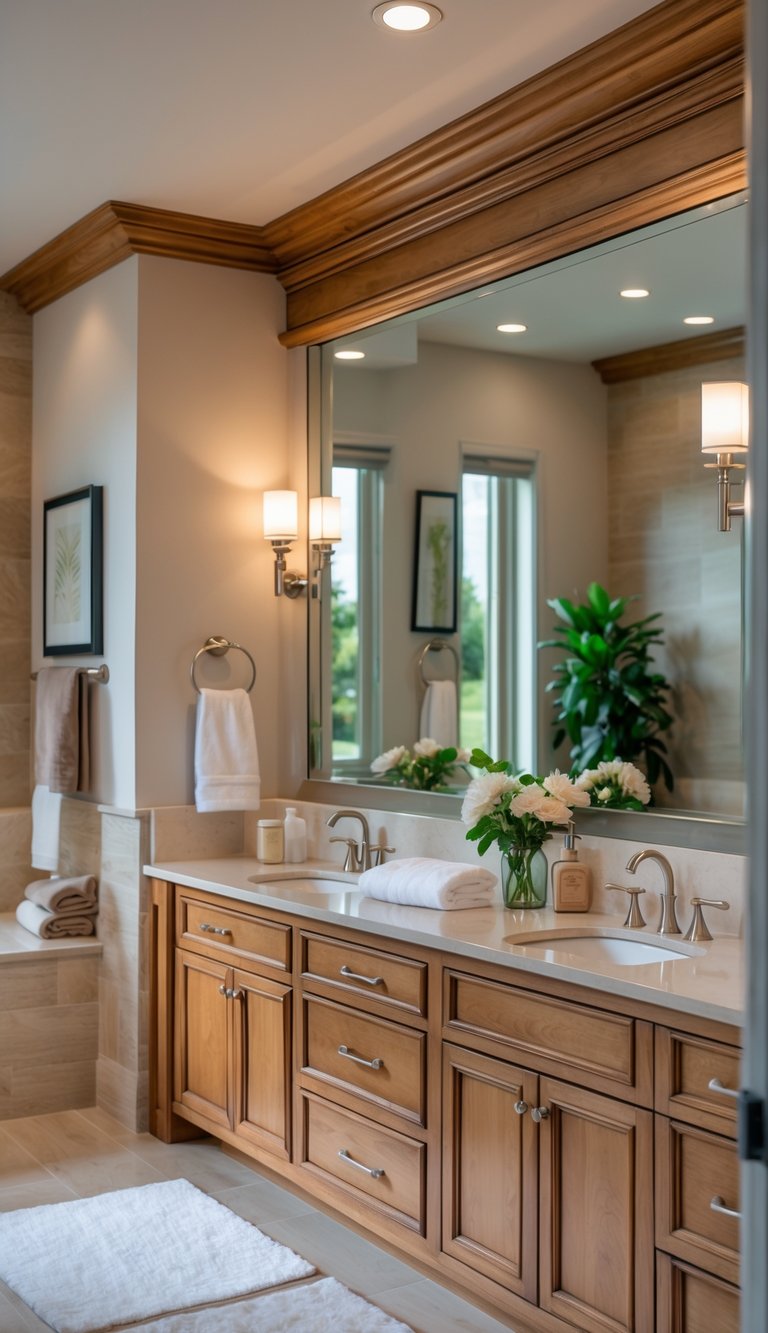
Transitional and classic vanities blend timeless style with everyday practicality. These designs strike a balance, so your bathroom won’t look outdated fast and you still get the storage you need.
Timeless Traditional Designs
Traditional vanities bring a sense of warmth and elegance. You’ll often find detailed woodwork, rich stains, and ornate hardware that make the space feel luxurious.
Look for cabinet doors with raised panels, carved accents, or beadboard textures. Woods like cherry, mahogany, and oak in deep hues add a classic touch.
Traditional vanities often feature:
- Crown molding along the top
- Furniture-style feet or turned legs
- Antique-inspired handles and knobs
- Marble or granite countertops
When you’re renovating, traditional vanities pair beautifully with classic fixtures like claw-foot tubs or pedestal sinks. The look feels established, maybe even a little nostalgic.
Blending Modern and Classic Elements
Transitional vanities mix traditional craftsmanship with modern simplicity. This style’s become a favorite for remodels because it’s so adaptable.
Key features of transitional vanities include:
- Clean profiles with just a hint of detail
- Neutral colors (think whites, grays, soft blues)
- Materials like wood paired with stone countertops
- Updated hardware in brushed nickel or matte black
Shaker-style doors fit perfectly in these spaces. They’re classic but not fussy.
Try pairing a transitional vanity with modern fixtures and a few traditional accents. You’ll get a space that feels fresh, but not overly trendy.
Furniture-Style Vanity Cabinets
Furniture-style vanities look more like standalone pieces than built-ins, so they really stand out. They can easily become the highlight of your bathroom.
Many furniture-style vanities come from:
- Repurposed antique dressers or sideboards
- Custom builds that mimic furniture
- Cabinets with legs and open shelves
These vanities usually sit a bit higher than standard, making them more comfortable for some people. You’ll often see turned legs, open shelving, and decorative hardware.
If you want to add some visual interest—especially in a powder room or guest bath where you don’t need tons of storage—a furniture-style vanity is a great choice.
Materials and Finishes for Durability and Beauty
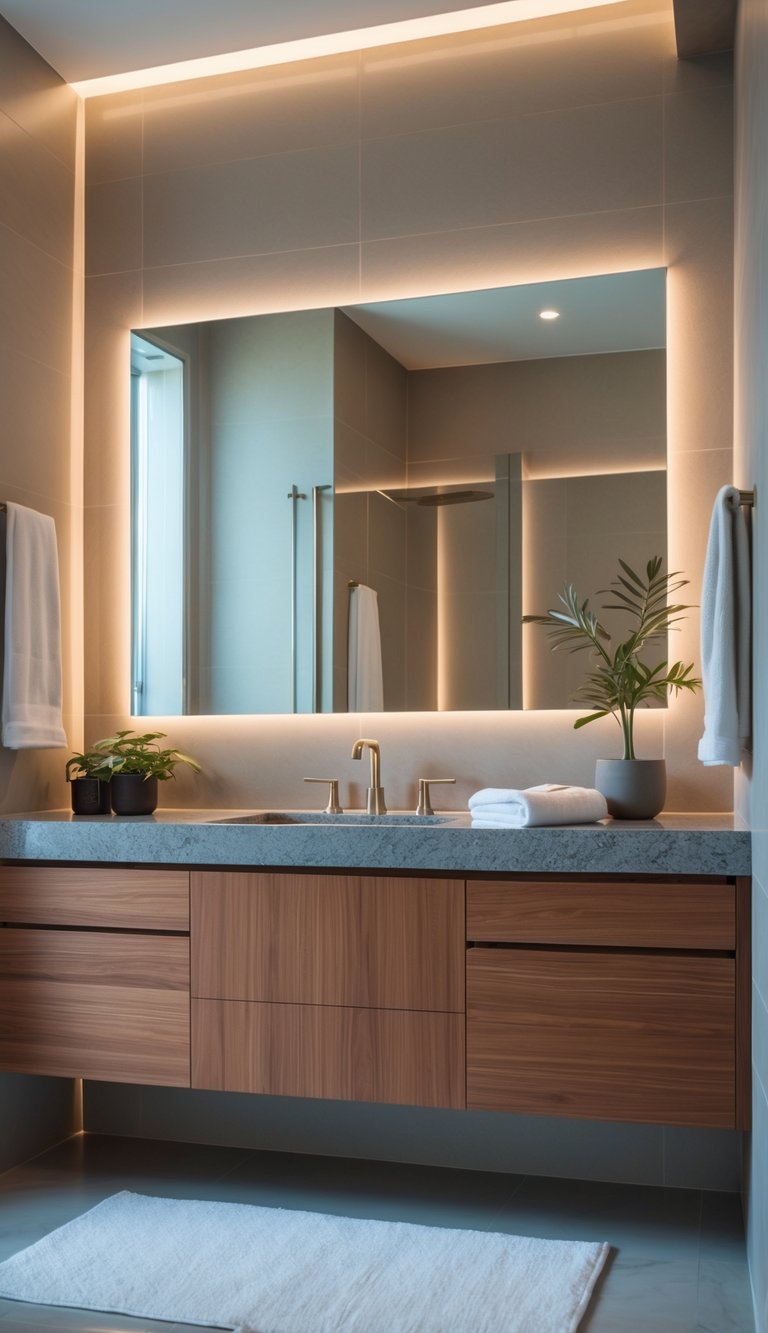
Picking the right materials for your vanity affects how it looks and how long it lasts. The best materials stand up to bathroom moisture and still look good years later.
Innovative Countertop Materials
Quartz tops the list for bathroom countertops—it shrugs off water damage and doesn’t need sealing. Unlike natural stone, it won’t stain from makeup or soap.
Solid surface materials like Corian offer seamless installation with built-in sinks, so there’s nowhere for mold to hide. You can find them in tons of colors and patterns.
Porcelain slabs are catching on since they’re tough and look like marble, but without the upkeep. They resist scratches, heat, and harsh cleaners.
If you’re eco-conscious, recycled glass countertops are a fun, unique option. Each one has its own patterns that catch the light in cool ways.
High-Performance Vanity Finishes
Solid wood still feels like the gold standard for cabinets, but you need to seal it well to handle bathroom humidity. Oak, maple, and walnut stand up best when treated right.
Water-resistant finishes have gotten a lot better. Look for:
- Marine-grade sealants
- Catalyzed lacquers
- Conversion varnishes
These finishes protect against moisture way better than standard furniture coatings.
Thermofoil and laminate options have come a long way, too. Newer versions mimic wood grain convincingly and resist water damage.
When you pick metal for drawer pulls or handles, consider brushed nickel or stainless steel—they handle humidity better than chrome or brass.
Space-Saving Vanity Solutions
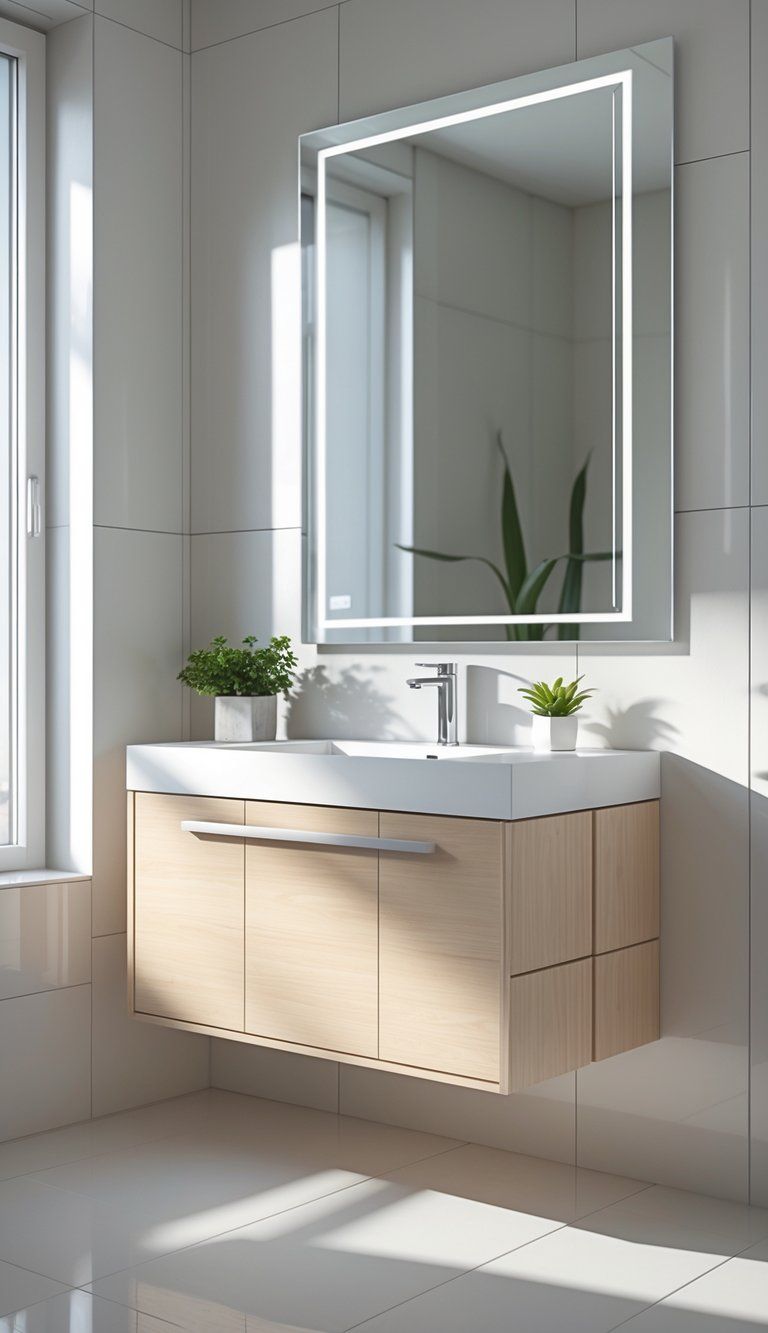
Small bathrooms need smart solutions. The right vanity can make even a tiny space feel stylish and usable, without giving up storage.
Compact and Corner Vanities
Corner vanities take advantage of tricky angles in small bathrooms. These designs fit neatly into corners and usually include shelves or a cabinet under the sink for your essentials.
Wall-mounted vanities help small bathrooms feel bigger by showing off more floor. The floating look makes cleaning easier, too. If space is really tight, pedestal sinks with slim shapes work, but you’ll need to stash your stuff elsewhere.
Narrow vanities (18-24 inches wide) fit in tight spots and still give you a bit of counter space. Some models even have towel bars on the sides for extra convenience.
Custom and Built-In Storage Ideas
Custom vanities let you use every inch of awkward space. You can have cabinets built to fit your bathroom exactly, with pull-out drawers and organizers to keep things tidy.
Built-in niches and recessed medicine cabinets add storage without sticking out. Some designs hide compartments behind mirrors or inside decorative panels.
Vertical storage—like tall, skinny cabinets—makes use of wall height instead of floor space. Add open shelves above the vanity for things you use a lot, so your countertop stays clear but you don’t have to dig for your essentials.
Functional Features Enhancing Daily Use
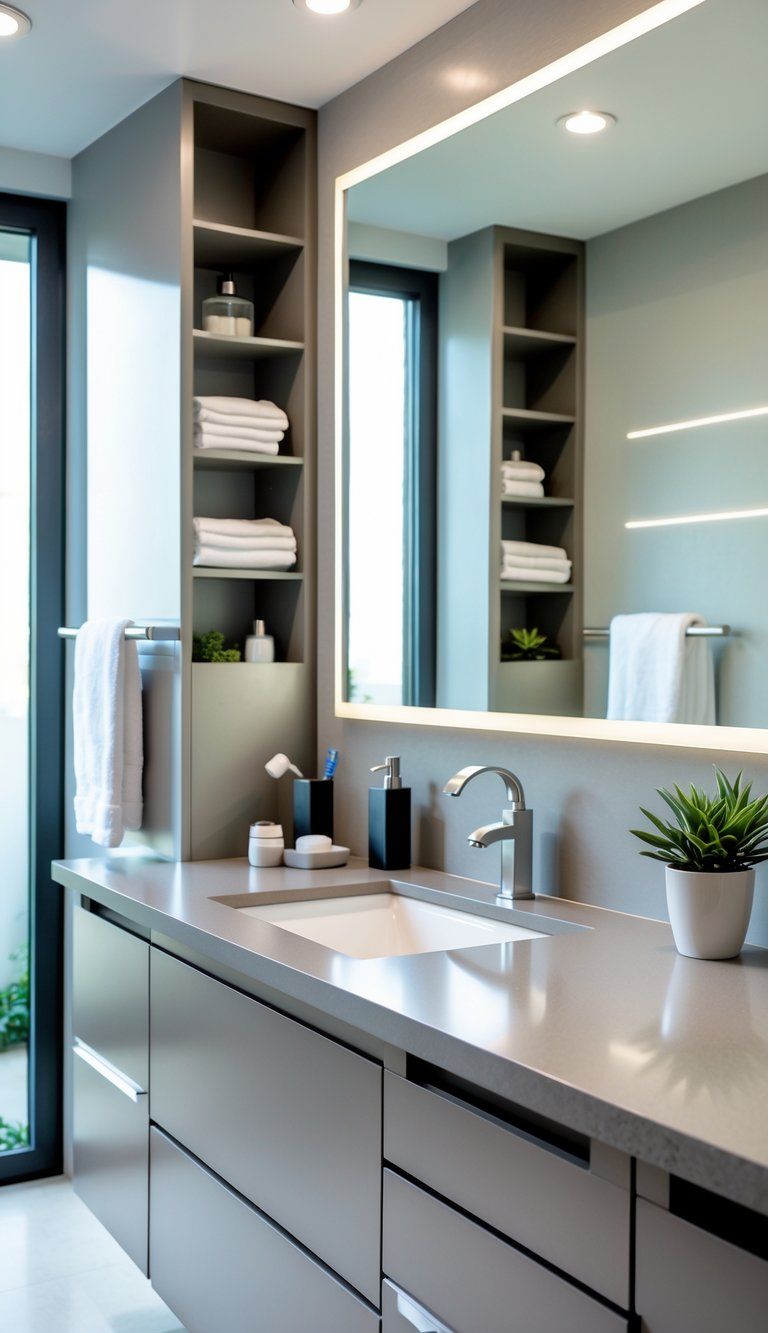
A good bathroom vanity should look great and actually make daily life easier. When you pick the right features, your morning and evening routines can feel much smoother—and maybe even a little less hectic.
Integrated Lighting and Mirrors
You really need proper lighting at your vanity for grooming. LED-integrated mirrors give off even, shadow-free light that feels a lot like daylight.
This kind of lighting makes things like makeup or shaving way easier.
Try to find mirrors with built-in anti-fog technology. These use gentle heating to keep steam from building up after a hot shower.
Some models even let you dim the lights, switch between warm and cool tones, or turn on with a wave of your hand.
Wall-mounted magnifying mirrors with adjustable arms come in handy for close-up work. You can move them exactly where you need and fold them away when you’re done.
Smart Storage Organizers
The right storage keeps your essentials handy but your counters clear. Pull-out drawers with dividers make it easy to organize makeup, hair tools, and toiletries.
You might want to try:
- Drawer organizers you can adjust to fit different items
- Pull-out hampers for tossing in dirty towels
- Hidden outlets inside drawers for charging hairdryers or shavers
- Vertical slots for hair styling tools
Those little tip-out trays at the top of false drawer fronts? They’re perfect for stashing razors, toothbrushes, or other small things you use every day.
Wall-mounted cabinets with adjustable shelves help you take advantage of vertical space. They’re a smart way to keep medicines and first-aid supplies safely out of kids’ reach.
Personalization and Customization Options
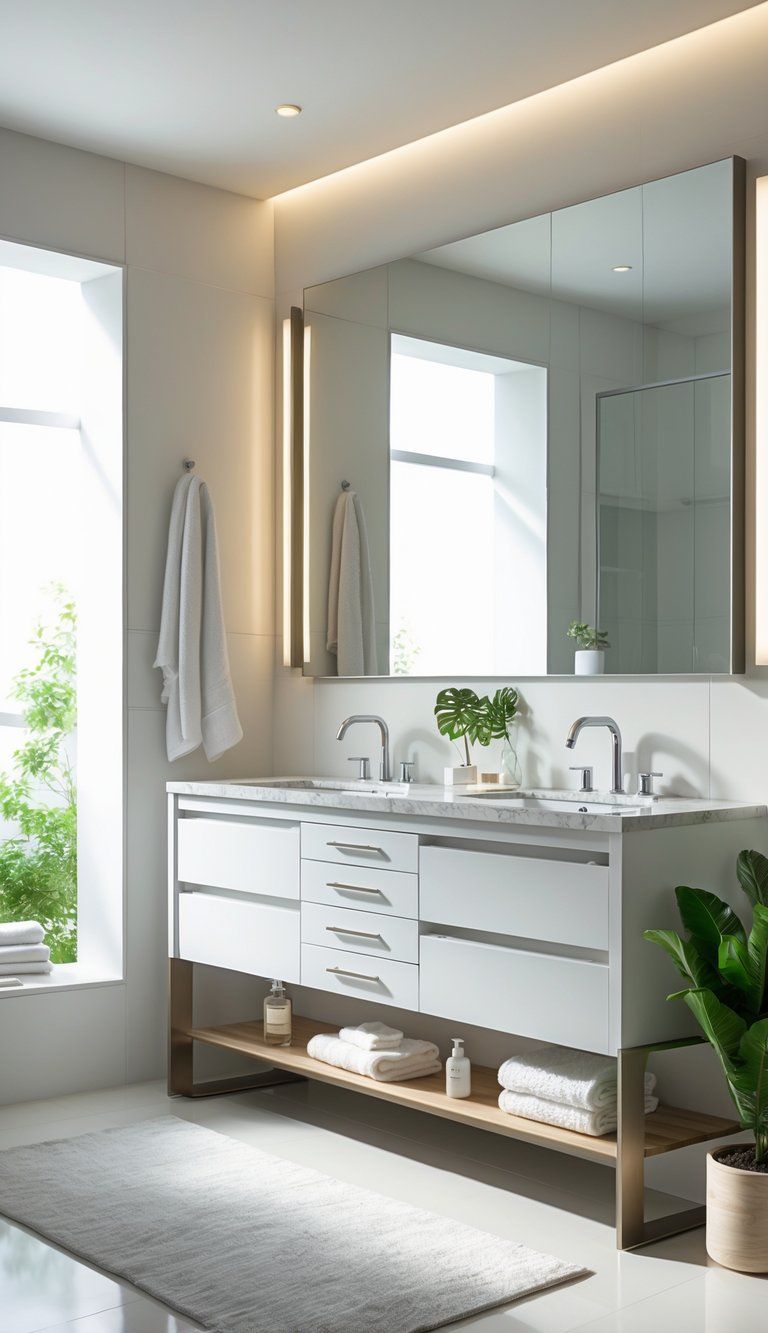
Custom bathroom vanities really open up a world of options. You get to pick materials, sizes, and finishes, so your vanity fits both your style and your needs.
Hardware, Colors, and Finishes
Choosing the right hardware can totally change the vibe of your vanity. Cabinet pulls and handles come in so many styles—sleek, modern, or even super decorative if that’s your thing.
Color’s another way to personalize. These days, you’re not stuck with just wood tones. Go for any paint color, a distressed vintage look, or even something bold if you want your vanity to stand out.
Material matters, too. Teak and walnut add warmth, while painted maple gives a crisp, classic feel. For vanity tops, you can pick from marble, granite, quartz, or even concrete.
A good provider who actually listens can help you sort through all these choices and steer you clear of expensive mistakes.
Selecting the Right Vanity for Your Space

Picking out a bathroom vanity isn’t just about looks—it’s about making sure it fits your space and your life. The right one gives you storage without making things feel crowded.
Assessing Space and Layout Needs
Start by measuring your bathroom. Most vanities run from 24 to 72 inches wide and about 20 to 24 inches deep.
Make sure you’ve got at least 30 inches of space in front so you can move around comfortably.
If your bathroom’s on the smaller side, wall-mounted vanities (sometimes called floating vanities) make the room feel bigger by showing more floor.
People usually install these about 30-36 inches off the floor.
Corner vanities work well in awkward spaces, and pedestal sinks fit nicely in powder rooms where you don’t need much storage.
If you have a large bathroom, double-sink vanities (60-72 inches wide) make sharing way less stressful.
Watch out for how doors open and how people move through the space. You don’t want your vanity blocking anything or making the room feel cramped.
In tight bathrooms, drawers are often easier to use than cabinet doors.
Budget and Quality Considerations
You’ll find vanities from about $200 for the basics up to $5,000 or more for custom designs.
Set a budget that covers the vanity and installation. Keep in mind that changing plumbing can get pricey fast.
Material makes a big difference for both cost and how long your vanity lasts. Solid wood looks classic but needs more care in humid bathrooms.
MDF with good veneers gives you a nice balance of price and moisture resistance.
Look for:
- Dovetail drawer joints for strength
- Soft-close hinges so doors don’t slam
- Sealed or treated wood to handle moisture
- Solid surface or quartz countertops for durability
Think about long-term value, not just the upfront price. A quality vanity might last 15 years or more, while the cheap ones could need replacing in five.
A lot of people end up happiest with something in the $500-$1,200 range—it’s a good sweet spot for quality and price.
Maintaining Style and Function Over Time
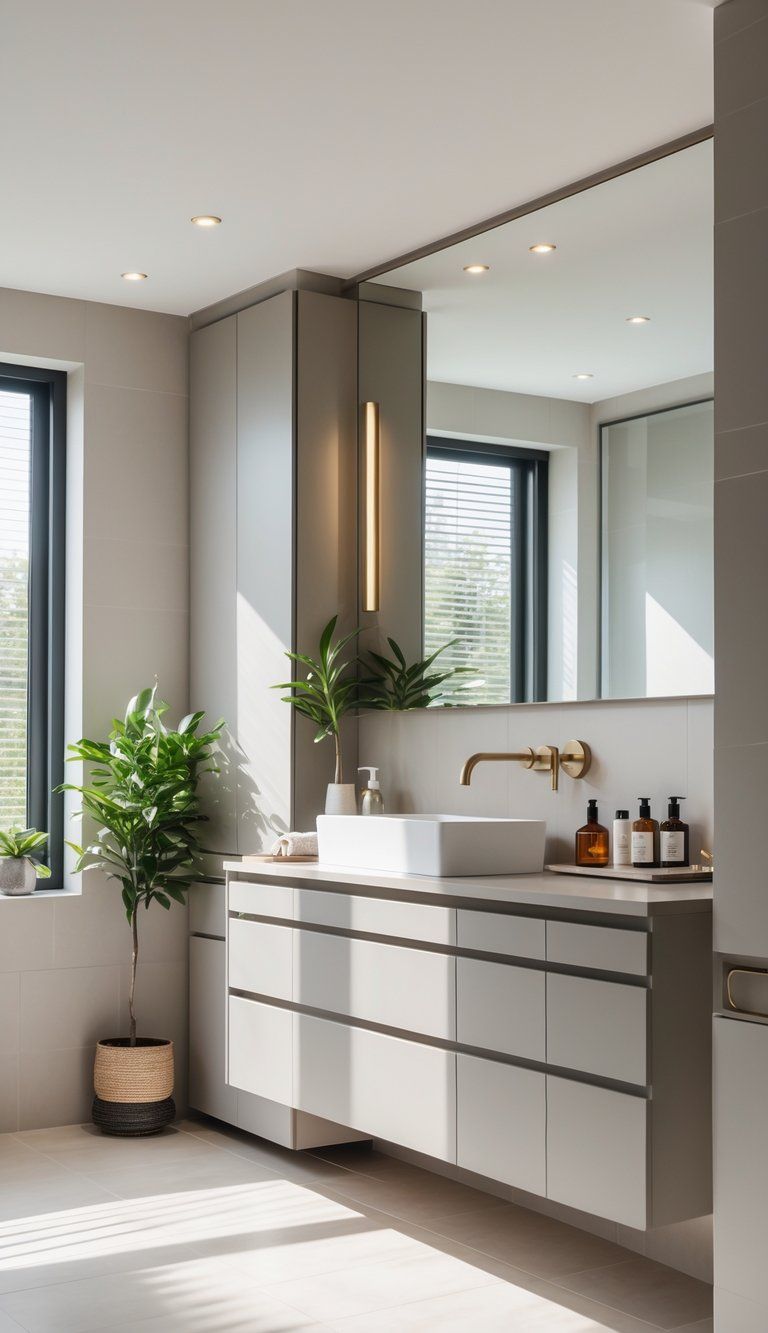
A beautiful bathroom vanity deserves some care to keep it looking good and working well. Regular maintenance helps your investment last and keeps your bathroom looking its best, year after year.
Routine Care for Longevity
Wipe down your vanity surfaces on a regular basis. Use cleaners that actually suit the material—wood vanities like something gentle and non-abrasive, but stone countertops? They usually need a stone-safe product.
If you spot a water spill, grab a towel and clean it up right away. Letting water sit just isn’t worth the risk of damage.
Take a peek at cabinet hinges and drawer slides every few months. Add a drop of lubricant to keep them moving quietly, and if you find a loose screw, go ahead and tighten it before it turns into a hassle.
Once a year, slap on a fresh coat of sealant for natural stone countertops. If you have a wood vanity, rub in some furniture polish or conditioning oil every few months—your finish will thank you, and it helps stop cracking or drying.
When caulking around sinks or countertops starts to look rough, just replace it. That quick fix keeps water out and helps your vanity stay looking sharp.

